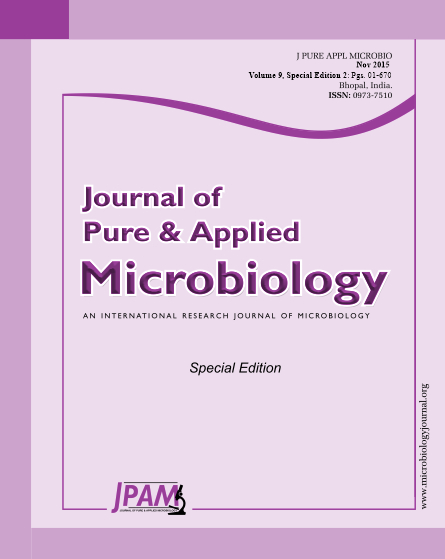The experiment was conducted under field conditions at Instructional cum Research Farm, College of Agriculture, Raipur (Chhattisgarh) during kharif season 2011-12. The data observed that treatment T2 (1.47%, and 65.42 kg ha-1) was recorded significantly higher N content % and N uptake ha-1 in the straw, followed by T9 (1.40% and 58.34 kg ha-1) and T7 (1.40% and 55.86 kg ha-1).Whereas, N content % and N uptake in grain recorded significantly similar results in the treatment T9 (6.31% and 157.12 kg ha-1) and T7 (6.29% and 153.04 kg ha-1). However, total N uptake by soybean was recorded significantly highest under treatment T2 (235.18 kg ha-1) followed by T9 (215.46 kg ha-1).Number of nodulation plant-1 was recorded significantly higher in treatment T6 (80.00) which was at par with T2 (79.33), T9 (77.67) and T7 (71.67). Dry weight of nodule, N content of nodule, number of pods plant-1, grain yield and straw yield was recorded significantly higher in treatment T2 (0.196 g plant-1,7.12%,34.12, 26.65 qha-1 and 44.51 qha-1) which was at par with T9 (0.187 g plant-1,6.89%,32.14, 24.90 qha-1 and 41.09 qha-1), T7 (0.181 g plant-1,6.82%,31.47 qha-1 and 24.33 qha-1), T6 (0.178 g plant-1,6.75%,29.60 and 23.92 qha-1) and T3 (0.170 g plant-1,6.73%,28.50 and 23.65 qha-1). Response of amended melamine phosphate on Rhizobial population, gram-1 of soil at 45 DAS T2 (11.03 gm-1 soil) was recorded significantly higher among all the treatments which was at par with treatment T9 (10.6 gm-1 soil) and T7 (9.99 gm-1 soil). Soil respiration and soil dehydrogenase activity was found significantly higher in treatment T9 (0.375CO2/hr/100g soil, 22.0µg/TPF/h/g soil) which was at par with T2 (0.367 CO2/hr/100g soil) and T7 (0.356CO2/hr/100g soil) incase of soil respiration and T2 (20.6µg/TPF/h/g soil) was at par in soil dehydrogenase activity.
Amended melamine phosphate, N accumulation, Rhizobium population, dehydrogenase activity and soil respiration
© The Author(s) 2015. Open Access. This article is distributed under the terms of the Creative Commons Attribution 4.0 International License which permits unrestricted use, sharing, distribution, and reproduction in any medium, provided you give appropriate credit to the original author(s) and the source, provide a link to the Creative Commons license, and indicate if changes were made.


